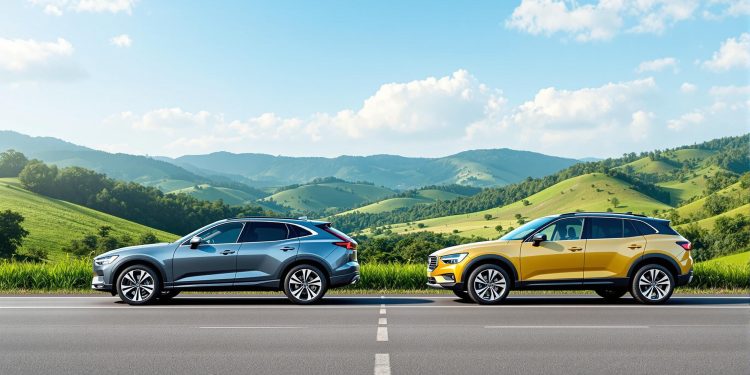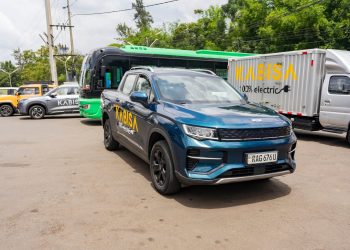Choosing between an SUV and a sedan for long drives in Rwanda depends on your route and needs. Here’s a quick summary to help you decide:
- Sedans: Best for paved highways and urban roads. They offer better fuel efficiency (30-40 mpg vs. SUVs’ 20-30 mpg) and a smoother ride on well-maintained roads.
- SUVs: Ideal for rural areas, national parks, and unpaved roads. They handle tough terrain with higher ground clearance, 4WD, and better durability.
Quick Comparison
| Criteria | Sedan | SUV |
|---|---|---|
| Road Type | Urban roads, highways | Rural, unpaved roads, parks |
| Fuel Efficiency | 6-7 L/100km (better) | 8.5-10 L/100km (higher usage) |
| Comfort | Smooth handling, less noise | Upright seating, better visibility |
| Cargo Space | Limited (2-3 suitcases) | Large (4-5 suitcases + gear) |
| Off-Road Ability | Struggles on tough terrain | Excels on steep, muddy roads |
| Safety | Better cornering stability | More protection in collisions |
For mixed usage, a compact SUV offers a balance of fuel efficiency and off-road capability.
Now, let’s dive into the details to help you make the best choice for your trip.
What’s safer: SUV or car?
Road Types in Rwanda
Rwanda’s road network spans around 14,000 km, but only 19% of it is paved [1]. While Kigali’s urban roads are well-maintained and smooth, the story shifts dramatically in rural areas.
City vs. Country Roads
In Kigali and other urban areas, paved roads make driving straightforward. Sedans thrive here, thanks to their lower center of gravity and better fuel efficiency. However, when you venture outside the city, road conditions vary widely, and the type of vehicle you drive becomes much more important:
| Road Type | Characteristics | Sedan Capability | SUV Advantage |
|---|---|---|---|
| Urban Roads | Paved, multiple lanes, good signage | Smooth handling, fuel-efficient | Comfortable, versatile |
| Major Highways | Mostly paved, well-maintained | Ideal for both | Ideal for both |
| Secondary Roads | Mix of paved and unpaved sections | Limited traction on unpaved | Performs better overall |
| Rural Roads | Mostly unpaved, unpredictable | Struggles in tough conditions | Handles terrain with ease |
Common Road Obstacles
Rwanda’s nickname, the "Land of a Thousand Hills" [8], isn’t just poetic – it directly shapes driving conditions. From steep climbs to muddy tracks, the terrain demands careful vehicle selection:
- Steep Inclines: Areas like Volcanoes National Park feature steep grades that can strain sedan engines. SUVs, with their higher ground clearance and more powerful engines, handle these challenges better.
- Rainy Seasons: During the rainy months (March-May and October-November), unpaved roads turn slippery and tough to navigate. SUVs equipped with four-wheel drive maintain traction far better than sedans.
- Surface Variations: Many rural or park roads transform into dirt tracks during rains, making SUVs the better choice for navigating these unpredictable conditions [3][6].
Though the Rwanda Transport Development Agency (RTDA) is working to improve infrastructure, vehicle choice remains critical for rural travel. These terrain differences also have a direct impact on fuel efficiency – something we’ll dive into next.
Fuel Costs and Usage
Choosing between an SUV and a sedan for long trips in Rwanda can have a big impact on your fuel budget. With fuel prices at 1,460 RWF per liter [7], understanding the differences in fuel efficiency is essential.
Gas Mileage Comparison
Fuel consumption varies significantly between SUVs and sedans, especially on Rwandan roads. Here’s a quick look at how some popular models stack up:
| Vehicle Type | Fuel Consumption (L/100km) | Cost per 500km* |
|---|---|---|
| Sedan (Toyota Corolla) | 6-7 | 47,450 RWF |
| SUV (Toyota RAV4) | 8.5-10 | 65,700 RWF |
| Hybrid Sedan (Prius) | 4.5 | 32,850 RWF |
| Hybrid SUV (RAV4 Hybrid) | 5.5 | 40,150 RWF |
*Calculated using average consumption and current fuel prices [1][3].
On routes like the Northern Corridor, steep gradients can reduce SUV fuel efficiency by 20-30% compared to sedans [3][6].
Electric and Hybrid Cars
Electric cars are becoming a bigger part of Rwanda’s vehicle market. AUTO24.rw made headlines in July 2023 as the first to import Tesla models [6]. Here’s how electric vehicles compare in terms of operating costs:
| Vehicle Model | Energy Consumption | Operating Cost/100km* |
|---|---|---|
| Tesla Model 3 (Sedan) | 14.9 kWh/100km | 3,800 RWF |
| Tesla Model Y (SUV) | 17.9 kWh/100km | 4,560 RWF |
*Based on industrial electricity rates of 255 RWF/kWh [9].
Hybrid models like the Toyota Prius (4.5L/100km) and RAV4 Hybrid (5.5L/100km) offer a middle ground, combining fuel efficiency with versatility. These options can lead to notable savings compared to traditional gas-powered vehicles [1].
Rwanda’s government is actively encouraging electric mobility by reducing import duties and expanding the charging network, which currently includes 200 stations [7]. Electric sedans, in particular, benefit from fewer charging stops on long trips compared to electric SUVs. This push toward electric vehicles ties into Rwanda’s broader commitment to eco-friendly transportation – a topic we’ll delve into further in Green Options.
Long Trip Comfort
When planning long journeys across Rwanda’s varied terrain, comfort plays a big role. Choosing between an SUV and a sedan can greatly influence your travel experience. From Kigali’s smooth streets to rugged rural paths, the seating and design of your vehicle can make all the difference.
Seat Design and Position
SUVs often come with higher, more upright seating, offering better visibility compared to the lower, reclined seats in sedans. For example, the Toyota Land Cruiser improves forward visibility by 20% compared to sedans [3].
On the other hand, sedans like the Toyota Corolla, which is popular in Rwanda, are designed to reduce driver fatigue during long highway drives thanks to their ergonomic seating positions [3].
| Feature | SUV | Sedan |
|---|---|---|
| Driver Position | Elevated (35° seat angle) | Reclined (25° angle) [3] |
| Fatigue Prevention | Absorbs rough terrain | Supports highway posture |
Storage and Space
SUVs clearly lead when it comes to cargo space. For instance, the Toyota RAV4 offers nearly 1,000 liters of storage, compared to the Toyota Camry’s 450 liters [1][3]. This makes SUVs perfect for multi-day trips to remote areas like Nyungwe or Volcanoes National Park.
| Vehicle Type | Cargo Capacity |
|---|---|
| SUV (RAV4) | Fits 4-5 large suitcases plus camping gear |
| Sedan (Camry) | Fits 2-3 large suitcases |
However, sedans have their perks too. They reduce wind noise by 15% when driving at 80 km/h [4], making them a great choice for smoother drives along Rwanda’s Northern Corridor highway.
sbb-itb-7bc66b5
Off-Road Performance
Driving through Rwanda’s rural areas requires more than just highway comfort – it demands vehicles that can handle tough terrain. The decision between an SUV and a sedan becomes crucial once you leave Kigali’s paved streets behind.
SUVs are built for this kind of challenge, offering:
| Feature | SUV Capability | Advantage for Rwanda |
|---|---|---|
| Drive System | 4WD/AWD | Better grip on unpaved roads |
| Suspension | Longer suspension travel | Improved shock absorption |
| Terrain Technology | Advanced systems | Adjusts performance based on road type |
Take the Toyota Land Cruiser Prado, for example. Its terrain management system adjusts settings automatically depending on the surface [1]. However, SUVs come with a trade-off: they consume 20-30% more fuel compared to smaller vehicles (see Fuel Costs).
Challenges for Sedans
| Limitation | Effect on Rural Driving |
|---|---|
| Low Ground Clearance | Higher risk of scraping critical parts |
| Basic Drive System | Struggles for traction on loose or muddy roads |
Sedans face real difficulties on Rwanda’s unpaved roads, especially during the rainy season when mud becomes a serious obstacle [10]. SUVs like the Toyota RAV4 strike a great balance, handling urban streets with ease while still being capable on rough terrain [1].
This difference in performance is especially important in emergencies, as explored further in our Safety Features section.
Safety Features
When deciding between SUVs and sedans for Rwanda’s long routes, safety features play a key role. Data from the Rwanda National Police highlights clear differences in how these vehicles protect passengers in various situations.
Crash Safety
SUVs, thanks to their higher seating position, offer better protection in frontal collisions, with a 15% lower fatality rate compared to sedans [1]. However, their added weight, while improving crash safety, also increases fuel consumption (see Fuel Costs).
| Vehicle Type | Pros | Cons |
|---|---|---|
| SUV | – 50% lower injury risk in crashes [1] – Better protection in rollovers | – 70% higher rollover risk [8] – 50% higher risk to pedestrians |
| Sedan | – 10% lower side-impact injury rate [4] – Better pedestrian safety – Lower rollover risk | – Less protection in head-on collisions – Lower profile in multi-vehicle crashes |
Modern safety technologies, like Electronic Stability Control (ESC), have improved safety across both types of vehicles. ESC-equipped models perform particularly well on Rwanda’s challenging roads.
Road Control
SUVs and sedans handle road conditions differently. Sedans perform better on winding roads due to their lower center of gravity, while SUVs excel in providing a wider field of view.
| Road Condition | SUV Performance | Sedan Performance |
|---|---|---|
| Wet Roads | 5% longer braking distance than sedans [2] | Best braking on dry surfaces |
| Mountain Roads | 40% higher rollover risk [5] | Better cornering stability |
| Urban Streets | 20% wider field of view | Superior maneuverability |
In Rwanda, 85% of new SUVs and 70% of sedans now come with standard ESC, a feature that reduces SUV rollovers by 50% [3].
Choosing between an SUV and a sedan depends on driving habits and risk factors. SUVs generally offer better crash protection, while sedans provide better handling on curvy roads and improved pedestrian safety in cities. These safety considerations also tie into Rwanda’s increasing interest in EVs, which we’ll discuss next in Green Options.
Green Options
As Rwanda focuses on eco-friendly travel, the environmental impact plays a key role in deciding between SUVs and sedans. The country’s goal of having 20% of vehicles electric by 2030 [1] makes choosing greener options more important than ever.
Electric Cars in Rwanda
AUTO24.rw is at the forefront of Rwanda’s electric vehicle market, offering models from Tesla and Chinese manufacturers. These efforts are backed by tax breaks and a network of 200 charging stations [1][7]. For longer trips, such as 500km journeys, electric SUVs need about 15% more charging stops compared to sedans because they consume more energy [6]. Drivers can explore options like the Tesla Model 3 (sedan) or Model Y (SUV), ensuring eco-conscious choices across both categories.
Emissions Comparison
Traditional SUVs produce 25-30% more CO2 than sedans [11]. While electric versions reduce this gap, SUVs still use more energy, especially on hilly terrain [4]. Thanks to Rwanda’s growing charging infrastructure, both types of vehicles are becoming easier to use. However, sedans remain the more efficient choice for long-distance travel, particularly on steep routes.
These considerations add an environmental layer to the decision-making process, complementing the practical factors discussed earlier.
Conclusion
When planning long drives across Rwanda’s diverse terrains, your choice between an SUV and a sedan largely depends on road conditions and the purpose of your trip. For those sticking to paved highways between major cities like Kigali, sedans stand out with their 20-30% better fuel efficiency [12] and lower maintenance costs [4]. They also handle exceptionally well on well-maintained roads, making them a smart option for regular intercity travel.
Rwanda’s infrastructure presents a duality: modern highways alongside rural trails that demand tougher vehicles. If your travels take you beyond urban areas or into national parks, SUVs shine with their higher ground clearance and durable suspension systems, offering the reliability you need [1].
Hybrid and electric vehicles are becoming more accessible in Rwanda, as highlighted in our Green Options analysis. Dealers like AUTO24.rw now offer models that help reduce the efficiency gap between sedans and SUVs. For eco-conscious drivers who still need off-road capability, compact SUVs strike a great balance [8].
Here’s a quick guide to help you decide:
| Driving Scenario | Recommended Vehicle |
|---|---|
| Urban/Highway Routes | Sedan |
| Rural/Park Visits | SUV |
| Mixed Usage | Compact SUV |
For the best value, consider renting vehicles tailored to your specific trip needs [1][4].
Related Blog Posts
- How Rwanda’s Hills Affect EV Range
- 10 Tips for Long Drives in Rwanda
- Top 7 Tips for Choosing Between New and Used Cars
- 5 Scenic Day Drives Near Kigali





